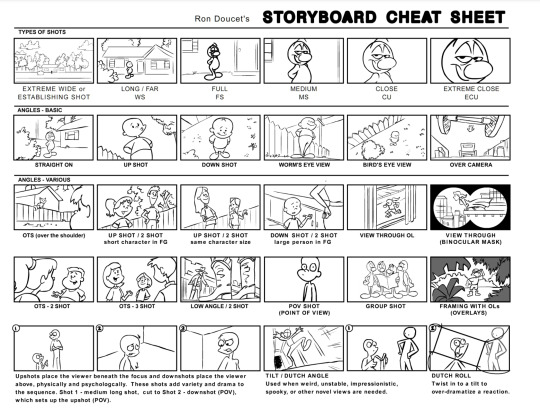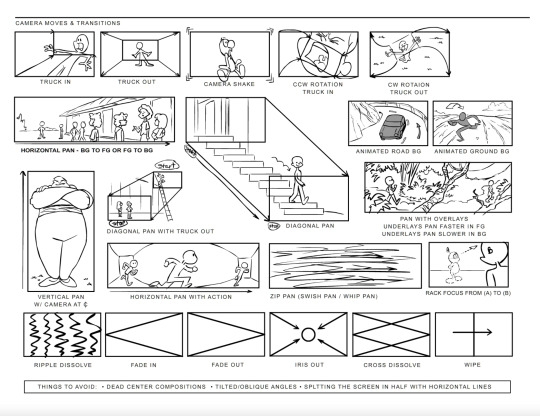Don't wanna be here? Send us removal request.
Text
Reflections
The past couple weeks have been some of the hardest of my adult life. Losing someone the same age as myself that I cared about so deeply was devastating; a real shock to the system and an unfortunate end to the semester/school year.
Looking back on my initial thoughts post, it is so interesting to see how quickly and drastically the style and aesthetic changed as my ideas developed. I am glad I was so onto it this class with keeping record of all my ideas as I know I was be coming back to this blog over the summer to complete my original idea of the poem 'Death' once enough time has passed.
What I ended up submitting was a much shorter rotoscope of the 1975 song "Love It If We Made It". I had set out to do the full 15 (more like 17) seconds of the dance, but stopped at 10 because I very honestly felt myself burning out with the stress of the tight deadline, work, and my current mental state. I made the choice of I would rather create 10 good seconds than 15 mediocre ones at the cost of my own well being.
Animation is something I have found a real love for this year and between DT2, Digi Character, and DT5 I have learnt so much that I will continue to come back to over and over again. I think the most important lesson I have (hopefully) learnt is things take a lot more time than you might think and to allow for that!
Watch this space, this isn't the end of my animation adventures - it is merely the beginning. Thank you Toby for sharing your knowledge with the class, grateful for your mahi.
1 note
·
View note
Text
Final Project
For my final project I decided to go down the rotoscoping route and for a first attempt at this technique, I think I did pretty good but I will go more into depth in my reflection post next.
Given my circumstances this semester, I was given the very generous option to only animate 15 seconds instead. Spoiler alert, I only managed to animate 10 seconds of the dance clip. If I wasn't about to leave the country for a fortnight I would have 100% finished the clip, if not created something a lot more in depth, but I am still insanely proud of what I managed to create despite it all.
She's short, she's sweet, she's for Sahara 🤍
0 notes
Text
Moving Forward
After taking the better (or worst) part of a week off to process everything, I started brainstorming my next move as continuing on with my "Death" poem right now was simply too difficult.
Initially I had considered animating a short clip of my Semester One Digital Character, Feya, but decided I wouldn't be able to her justice in her animation debut with the remaining time period.
I then explored more light hearted and funny concepts inspired by comic strips like Cyanide and Happiness, taking existing funny/dumb jokes and animating them - but ultimately decided I wasn't in a headspace to do something funny and witty right now.
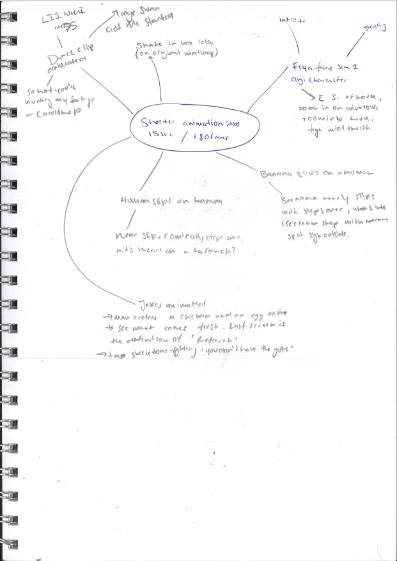
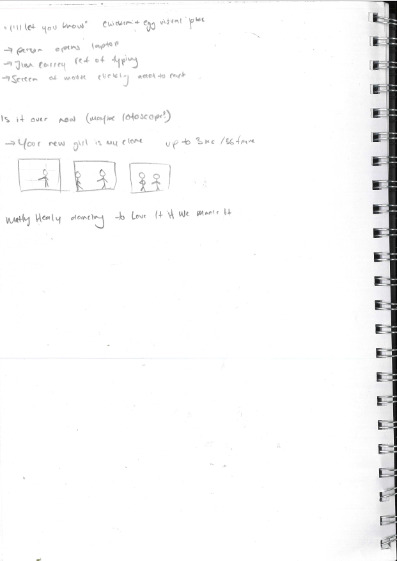
I honestly found myself at this point in quite the creative rut and struggled immensely as soon as I took an idea forward into the story-boarding phase. That's when I came across this Youtube Short while looking for inspiration:
Rotoscoping is an animation technique that animators use to trace over motion picture footage, frame by frame, to produce realistic action. Rotoscoping can allow you to create more stylized or artistic effects, such as cartoon-like animation or silhouette-like cutouts. However, also has some disadvantages, such as being time-consuming, tedious, and repetitive.
While I understand this process will be very time-consuming and I am on a very tight deadline, by rotoscoping an existing dance video I am taking away the mental labour of story-boarding that was holding me back from continuing on with my animation.
The first dance I had contemplated animating was the current Tiktok dance trend to Taylor Swift's "Is It Over Now?". While I had a few ideas of how I would make this dance visually interesting when rotoscoped, the dance is only 10 seconds long and wouldn't be suitable to the 15 second minimum time limit I have been given.
After spending a good couple of hours looking at dozens of dance videos, I remembered an iconic 1975 (Sahara's favourite band) dance to one of Sahara's favourite song and knew this would be my final animation:
youtube
1 note
·
View note
Text
Crow Reference Images/Videos
Understandably so, I am struggling to find a happy medium with this project that allows me to use the audio I have worked on in a way that isn't too triggering since Sahara's death.
I have wanted to include bird imagery since the early planning stages as a representation of death and transformation. This post will be the master post of bird references.
I had wanted to incorporate bird imagery on each of the "Death.." lines but in a different way each time. I will upload story board scans in a different post.
For the first "death", I want to have a crow flying onto screen with a zoom in on their eye being swallowed for the line "I would eat them".
For the second "death", I plan on having birds come flying out from behind the woman on the moon.
For the third and final "death", I plan on having a woman centred with crow wings spreading behind her.
youtube
youtube
youtube
youtube
0 notes
Text
Death by Donald Revell
As we entered the second week of DT5 I began fleshing out the audio track that would form the basis of my animation. I recruited the help of my flatmates boyfriend, Will, to do the voice over, and I spent countless hours listening to endless piano tracks to find the one that spoke to me the most.
I eventually came to the decision to use Two Birds by Fredrik Lundberg as my backing track, and to only use the middle section of Death as I felt like I could create a really compelling narrative with that material - and also knew I only had a few weeks to achieve this project. Here is what I am using, and here is where you can read the full poem:
"Death," I said, "if your eyes were green I would eat them."
For what are days but the furnace of an eye? If I could strip a sunflower bare to its bare soul, I would rebuild it: Green inside of green, ringed round by green. There'd be nothing but new flowers anymore. Absolute Christmas.
"Death," I said, "I know someone, a woman, Who sank her teeth into the moon."
For what are space and time but the inventions Of sorrowing men? The soul goes faster than light. Eating the moon alive, it leaves space and time behind. The soul is forgiveness because it knows forgiveness. And the knowledge is whirligig. Whirligig taught me to live outwardly. Shoe shop. . . pizza parlor. . . surgical appliances. . . All left behind me with the hooey. My soul is my home. An old star hounded by old starlight.
"Death, I ask you, whose only story Is the end of the story, right from the start, How is it I remember everything That never happened and almost nothing that did? Was I ever born?"
Here is a few of the key saves from my audio editing process:
Here are some of my early scribbles for this narrative:
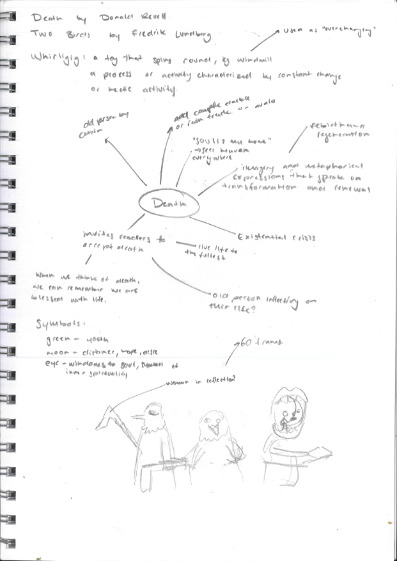
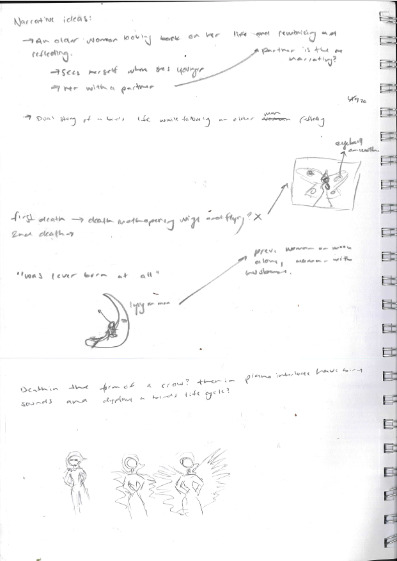





My writing is absolute chicken scratch, but key ideas that I have been floating include abstract moments on the "death" lines that include a mouth swallowing the moon, a representation of death moving closer on each "death" line, as well as more narrative features like an older figure reflecting back on their life.


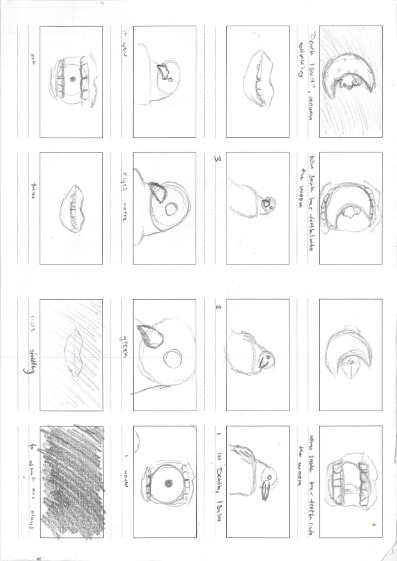
In my research and brain storming I came to realise this poem uses imagery and metaphorical expressions that speak on transformation and renewal, and what better way to represent both death and transformation/renewal than through the feature of birds - hence why the bird song got added into the track.
I also felt this was a perfect metaphor to explore since the track I was using was titled "Two Birds".
Expanded ideas on birds:
Bird having a love story
Bird reflecting on a human love story/life cycle
Bird going through a life cycle
"Death" lines could include birds flying out from behind a character
"Death" lines could have character turning into bird/grow wings
Bird watching from a cage, revealed at end
I will include my current mood board in my next post as I breakdown different elements and aesthetics I am currently wanting to explore.
It also feels odd to continue on with this project without discussing something tragic that occurred over the weekend (Nov 3/4). One of my dear friends, Sahara, unfortunately passed away. I contemplated scrapping the idea entirely and starting again - and who knows, I still might - but decided that while this is a poem about death, it is actually a poem that celebrates life.
Craig Teicher writes, "the poem proposes a mighty act of communion, a gathering together of readers and writers, speakers and listeners, living and dead. This is a poem of deep empathy, of comforting and keeping company. Revell wants us to feel less alone and less afraid to die, whatever we believe. Revell’s poem can help us: so that when we think of death, we can remember we are blessed with life."
I feel so incredibly blessed I got the opportunity to meet Sahara and call her a friend, her death is a tragedy that will weigh heavy on the hearts of everyone that knew her. I dedicate the remainder of this project to the light she brought into every room, to the warmth she brought into everyone's lives. She will be so deeply missed.
0 notes
Text
DT5 Final Project: Initial Thoughts
Last semester saw us in DT2: Animation create a 20+ second narrative animation to demonstrate our understanding of the 12 Principles of Animation. This semester in DT5 we were given a variety of different options including: kinetic typography, animated character suite, stop motion, as well as animated short film.
I knew I wanted to create another animated short film, and within this category I knew it would either be a narrative, an audio track animated, or some hybrid in the middle.
Here are my first brainstorms:
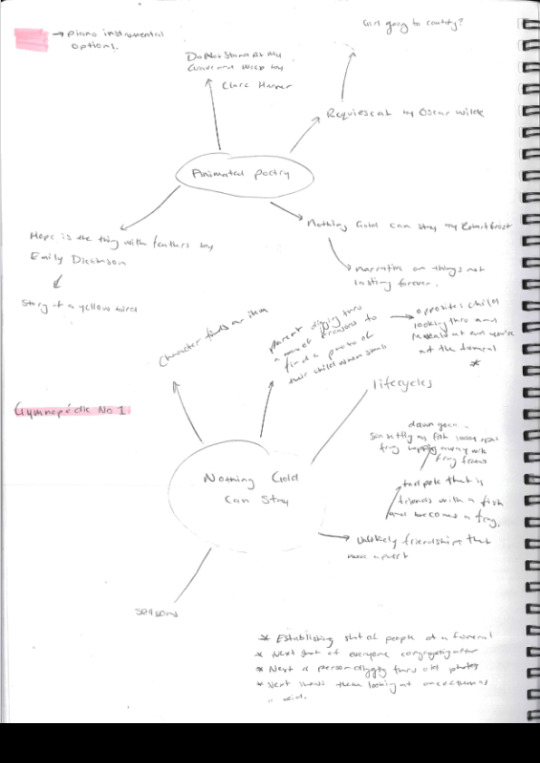

At this stage I had no idea WHAT story I wanted to tell or exactly how I wanted to tell it, but initially I was leaning towards this kind of vector aesthetic. Leaning into clean shapes:








This then transformed into an aesthetic of bolder shapes with black linework representing the details, done in squigglevision style:






I further experimented with this style before ultimately changing my mind and exploring other ideas:

In terms of early narrative content inspiration and ideas, before reaching squigglevision territory I had been contemplating animating a much love childhood story of Ko Rona me te Marama. I also spent some time researching nursery rhymes and other bedtime stories as I explored potentially making something for my young niece.
By the time I reached squigglevision I was entering into poetic waters and decided I wanted to animate a poem. I spent an afternoon trolling through the internet looking through dozens of poems before reaching a finalist list of:
Nothing Gold Can Stay by Robert Frost
Hope is the thing with feathers by Emily Dickinson
Death by Donald Revell
0 notes
Text
Hayao Miyazaki Translated Notes
Translated notes and drawings of kids running by Hayao Miyazaki. Animated on twos so suited to 12 frames a second animation, which is the frame rate of my narrative animation project.




0 notes
Text
Walk Cycles

A walk cycle is traditionally composed of 8 frames of animation. However, more recent walk cycles have been created with fewer or more frames, depending on the style and needs of the project. For example, a walk cycle for a video game might be composed of 12 frames to allow for smoother movement. Ultimately, the number of frames in a walk cycle will be determined by the animator or team creating the walk cycle. On average, in a normal walk cycle animation a character usually takes two steps in 1 second (24 frames).
Four key poses:
Contact (Keyframe): Both feet are in contact with the ground and the weight of the body is split between each leg.
We’ll need 3 contact poses. On frame 1 will have the left leg forward on frame 13 will have the right leg forward and on frame 25 it will be a repetition of frame 1
Passing (Keyframe): One foot is planted on the ground while the other is lifted. And both feet are passing to the next contact pose.
It’s adding change to our animation right in the middle of each step on frame 7 and frame 19. The hips are generally a touch higher than they are in a contact so we establish a bit of up and down – between the 2 poses – a tiny sense of gravity and weight.
Downs (Extreme): In the down pose we get compression in the whole body. Not only is the character at his lowest point in vertical space – but there’s a big bend in the knee on the planted foot as the hips and the spine curl forward on frame 4 and 16.
Ups (Extreme): In the up pose we get the opposite – of COURSE – an extension. A stretch to the planted foot – with a tilt up and back in the hips and spine on frame 9 and 22.
Key pose breakdown:
In the contact position the hips are rotated towards the leg that’s forward because that’s what pulls the leg into position.
The arms are opposite what the legs are doing for natural momentum. And the upper body gets the arms into position, by opposing the hips while at the same time helping to keep us balanced.
As walking is a process of falling forward and catching ourselves – we tend to be rotated slightly forward throughout a normal walk.
The faster a character moves, like in a run, the more we tend to rotate forward as we go.
Walk cycle inspiration:
0 notes
Text
Appeal
This principle can really come down to adding more appeal (charisma) in many different areas of your animation, such as in posing. The most obvious example, however, is appeal in the character design because you want to have a character that the audience can connect with or relate to, whereas a complicated or confusing character design can lack appeal.
Appeal is not only used for the lead characters. But also villain, sidekick and every other character:
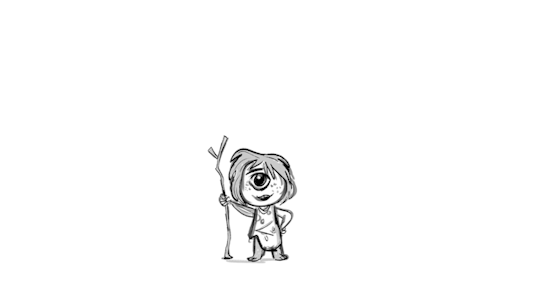
Instead of using the same variety of shapes to all the characters, You can play with them in shape variation and use it according to their personalities:

0 notes
Text
Solid Drawing

Solid drawing is the animation principle which makes the drawing looks three dimensional and believable with Volume, Weight and Balance. With solid drawing you will able able to draw figure from any side, which will help in animating your drawing.
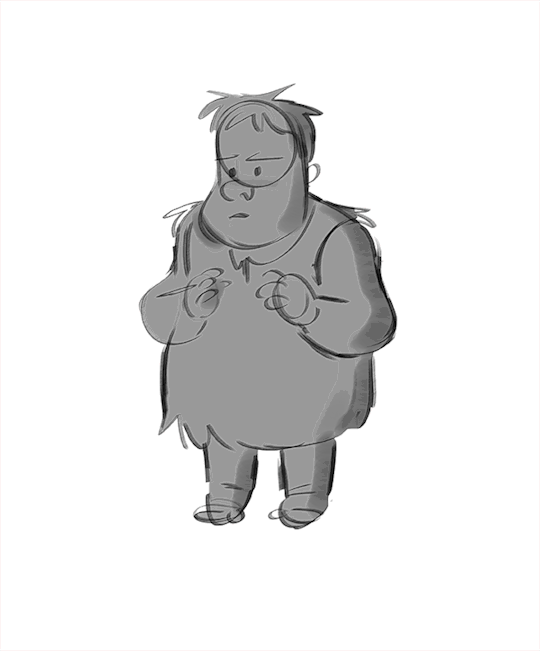
Whilst converting a solid drawing to its animation, the animator has to ascertain that the mass, size, and shape are created according to the characters’ personalities and needs. For example, when you draw a cube, you cannot use parallel lines as that will remove depth from the picture and make it look flat. To make the object look 3D, lines need to be merging towards a vanishing point.

Rough pass of designing a character with solid shapes:

0 notes
Text
Exaggeration
According to Oxford Dictionary, ‘exaggeration’ refers to the act of making something seem larger, better, worse, or more important than it is.

Exaggeration is used to push movements further, adding more appeal to an action, and should always be implemented to some degree.
Exaggeration can be used to create extremely cartoony movements including physical alterations or supernatural elements. Or, exaggeration can be incorporated with a little more restraint for more realistic actions. But, even then you can still use exaggeration to make a more readable or fun movement while still staying true to reality.
Application in animation:
An example of the application of exaggeration can be seen with animating the character expressions. If the character is sad, make the character look more sorrowful. If the character is having fun, make the character look brighter. If the character is nervous, make the character look shakier. Likewise, with other expressions, you need to make them more intense and nuanced. Exaggeration does not make the action less believable, it instead makes the action look more convincing.
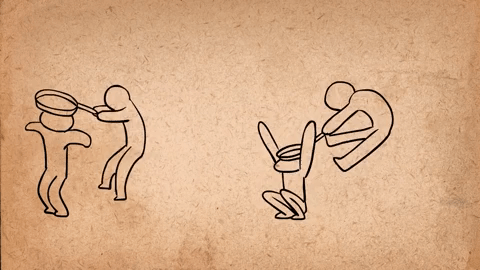
In the case where the movement is fast, the exaggeration element needs to become more noticeable for the audience. When the frame is still, the drawing looks too exaggerated to be realistic. However, when you put it in motion, the drawing looks more realistic. This is because, in that sequence, the normal number of frames is higher than the number of frames using exaggeration, so making your eyes take in it all in a short time will create the above feeling. Thus, to increase the presence of frames containing the exaggeration element, you need to make the frame appear on-screen longer or make the frame more exaggerated & stylized.
0 notes
Text
Secondary Action
This is an additional action that supports the main act. A secondary action is an integral part of animation as it adds interest and realism to the scene. It originates from immediate action, such as when someone’s arm moves backward after throwing something forward.
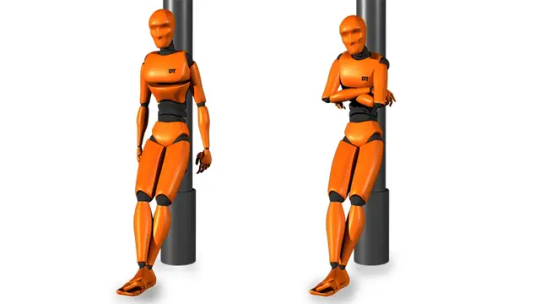
Let’s say a character is talking to another character in a waiting room. The two of them talking would be the main action, but if one of them begins tapping their foot nervously, that would be the secondary action. Other examples would be a character whistling, leaning on a wall, or crossing their arms while a primary action is taking place.
How to create secondary action:
To create a secondary action, the animator needs an image that illustrates the main idea. Then the secondary animation becomes a movement that happens depends upon the first image, an active motion. For example, when someone shakes their head, the primary action would be the head itself, and things such as hair or floppy hats are examples of secondary motions.
Important to note that if you stripped away the secondary action, the primary action should still be clear.
0 notes
Text
Arcs
Arcs are circular paths taken by an object or action in animation.

Everything in real life typically moves in some type of arcing motion. Since it's unnatural for people to move in straight lines, you should adhere to this principle of animation to ensure you get smooth, realistic movements. The quicker something moves, the flatter the arc and the broader the turn. The only time something would move in a perfectly straight line is a robot.
If a character is turning his head, he will dip his head down during the turn to create an arcing motion. You also want to ensure that more subtle things move in arcs. For example, when a character walks, even the tips of their toes should move in a rounded, arcing motion.
0 notes
Text
Slow-In and Slow-Out
Most characters and objects accelerate and decelerate when moving. Most movements are not linear, therefore to reproduce the slow-in and slow-out effects, we add more drawings closer together at the beginning of the action and same at the end of the movement. The closer the drawings are, the slower the animation will be. The farther apart they are, the faster the animation will be.

0 notes
Text
Follow Through and Overlapping Action
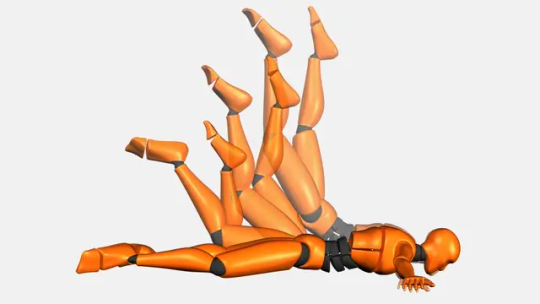
Follow through is the idea that separate parts of the body will continue moving after the character has come to a stop. As a character comes to a stop from a walk, the arms may continue forward before settling in a down position. This could also be the case with articles of clothing.
Overlapping action (also called “drag” or “lead and follow”) is very similar in that it means different parts of the body will move at different times. An example of overlapping action is when a character raises their arm up to wave: The shoulder will move first, then the arm, and then the elbow, before the hand lags behind a few frames. You can also see this when a blade of grass waves in the wind. The base moves first and then the rest of the grass follows behind at different rates, giving it that waving motion.
Additionally, characters who are remaining still need to display some sort of movement (blinking eyes, breathing, etc.) to prevent the animation from becoming “dead.” This is called “moving hold.”
0 notes
